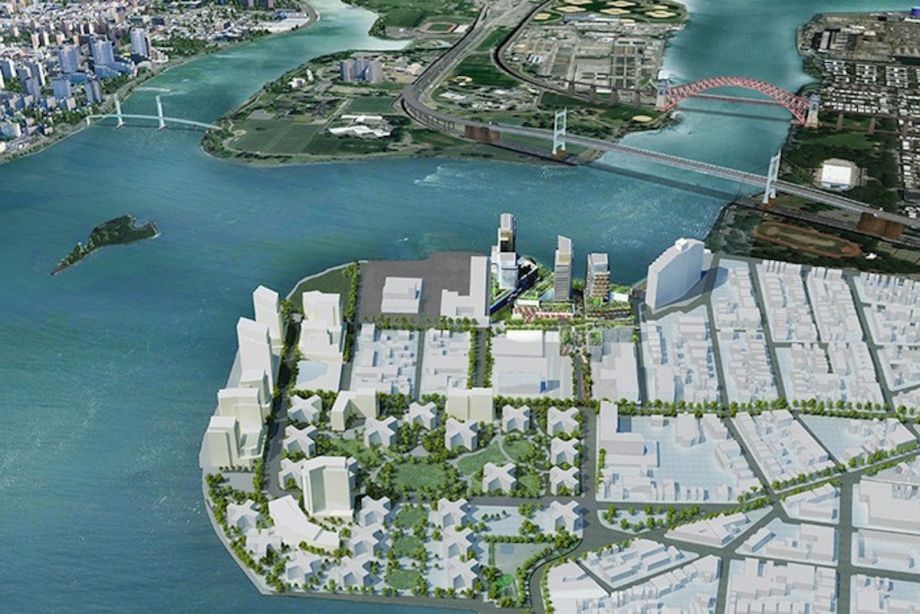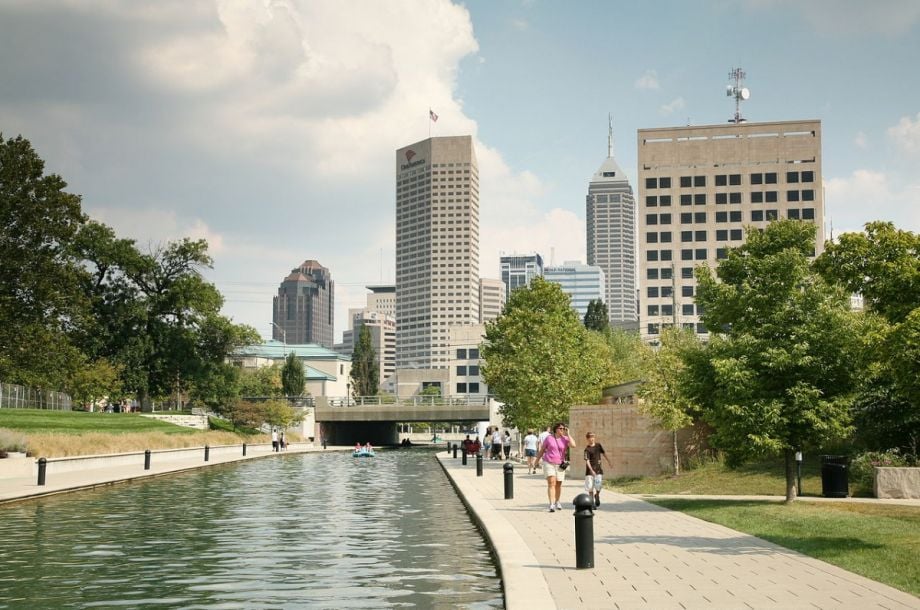Los Angelenos May Soon Have More Power to Save Treasured Landmarks

(AP Photo/Mark J. Terrill)
The “tamale building” has been a mainstay in its East Los Angeles neighborhood since its creation in the 1920s, despite ceasing to operate 30 years ago as an eatery — that once served, of course, tamales. Lauded by some for its quirkiness and heralded as a symbol of Hollywood’s past, the building (which now houses a beauty salon and a dentist) also has opponents who consider it more an eyesore and a detriment to the land’s economic value.
Now, amid ongoing battles that put real estate values in one corner and community history in another, the Los Angeles Board of Supervisors is expected to pass new preservation guidelines that could enable individuals to nominate certain properties as landmarks in unincorporated areas of the county, such as where the tamale building is located in East L.A.
“The tamale building in East Los Angeles is an example of a type of architecture that created very unique structures in different places of the county to help promote businesses,” County Supervisor Hilda Solis told Fox News. “We need a mechanism that will allow for the historic preservation of such sites so that the community can have a say on whether they should be preserved.”
The new ordinance would mean a much more open nomination process before beloved structures face the usual political approvals. There is some trepidation that a more egalitarian nomination process would mean a flood to a system already knee-deep in requests. If the ordinance passes, however, “the tamale” will be at the top of many conservationists’ lists.
Marielle Mondon is an editor and freelance journalist in Philadelphia. Her work has appeared inPhiladelphia City Paper, Wild Magazine, and PolicyMic. She previously reported on communities in Northern Manhattan while earning an M.S. in journalism from Columbia University.
New Worker Co-op Could Shift Queens Gentrification Story

A community benefits arrangement connected to the Astoria Cove real estate project (rendering above) sets aside quality jobs for locals. (Credit: Studio V Architects)
Overlooking New York’s East River is a tiny peninsula off the northwest tip of Queens known as Hallets Point. It shares the same name with the poorest neighborhood of the borough, just a little to the south, a high-poverty pocket of middle-class Astoria. It’s also on the cusp of robust residential development that stands to forever alter its makeup.
At a presentation to community members last year, an architect of one of two proposed mixed-use megaprojectsdescribed the peninsula changing from a place “cut off from Astoria” and a “desolate eyesore,” into a waterfront site that will be “one of the most magical, outstanding sites in New York City.”
For many nearby public housing residents, the proposed transformation had all the makings of a familiar script: development and upheaval, followed by wealth and higher-paying jobs open predominantly to newcomers and increased inequality.
However, a pioneering community benefits arrangement — one that sets aside quality jobs for local residents both during and after construction — could see “gentrification” play out differently in Hallets Point.
Astoria Cove has had its run-ins with controversy, but prior to city council’s sign-off on the real estate project last November, essential concessions were leveraged from the developer, Alma Realty. Among them: Alma had to refurbish a local park and use union labor during construction, and upon completion, employ a cooperatively owned security company.
“That was very interesting and novel,” says Christopher Michael, executive director of the New York City Network of Worker Cooperatives. “A part of the criteria for having a real-estate development project approved was to agree to give preference to a worker cooperative and only do certain business with a worker cooperative.”
Details released to the public in July highlight just how novel: The security company that was selected, On Point Security, will be the city’s first-ever worker co-op controlled by public housing residents.
To start, community development nonprofit Urban Upbound “owns” On Point Security, which launched this summer. But true to the work-to-own model, control will transition to the workers in short order. “Our framework is one year,” says On Point Security general manager Fritz Vincent, who isn’t a resident of public housing and won’t have an ownership stake, but has 25 years of experience in the security industry to help train the employees.
Vincent is versing the team in everything from anti-terrorism tactics to the administrative duties of a cooperative — background on being both guards and owners. “The pathways to ownership will consist of taking classes in business management, what it takes to run a cooperative, managerial classes. All while working, while receiving pay,” says Vincent. Through this coursework, they’ll obtain credits that will lead to becoming shareholders.
There are seven men currently in the program, and another 23 in the pipeline. All have experience or demonstrated interest in security and business ownership, and they’re all tenants of the New York City Housing Authority. (NYCHA’s a partner in the effort, along with financial backer Citi.) All of On Point Security’s workers live specifically in NYCHAhousing in Queens, but Urban Upbound’s long-term co-op plans include expansion to all five boroughs.
“This is a model that we believe can build a pathway out of poverty, a new approach to wealth creation for neighborhoods undergoing economic development,” says Urban Upbound’s Amir Bassiri.
Councilman Costa Constantinides, who represents Astoria, shares the sentiment. “This is giving men and women the opportunity to be their own boss,” Constantinides says. “It’s teaching them how to build equity and become an owner of their own business. It’s really taking a holistic approach to financial health and lifting the residents of public housing up.”
Popularized in Europe during the 1970s and ’80s, there are more than 300 co-ops in the United States. They’ve received recent attention for supporting equitable wages and business practices, thanks to successful examples like Cleveland’s Evergreen Cooperatives. Though other cities have tried to replicate the Cleveland model with varying degrees of success, Rochester, New York’s mayor recently eyed Evergreen as a poverty-fighting solution. Last year, New York’s city council allocated $1.2 million to encourage more co-ops — a first for a U.S. city.
Urban Upbound expects On Point Security to be the first of many co-ops it launches (the group is also researching grocery stores, green construction and daycare), and the Astoria Cove agreement sets a notable precedent. If it’s replicated amid New York’s growing real estate boom, there could be major benefits for workers, says Christopher Michael: “In the future, every new development that the city approves could have to contract with On Point Security or an as-yet-to-be-named worker co-op security company.”
The Equity Factor is made possible with the support of the Surdna Foundation.

Malcolm is a Next City 2015-2016 equitable cities fellow. He has contributed writing and research for The Atlantic and Philadelphia magazine, among other publications. He’s appeared on NPR’s “On The Media” and “All Things Considered.” He lives in Philadelphia.
How $500 Million Turned Car-Centric Indianapolis Into a More Walkable City

(Photo by Daniel Schwen)
Low-slung homes, green lawns and no sidewalks: Many neighborhoods just outside downtown Indianapolis showcase the suburban ideal of the 1950s and 1960s. Developed at the height of the automobile, they made Indiana’s capital city a car-centric town. Paths are sometimes worn through the grass like an urban trail, a stripe of pounded dirt cutting through the green that marks how residents have nonetheless found a way to walk their dogs and visit their neighbors on foot.
Despite the apparent need for sidewalks, Indianapolis went more than 20 years without constructing one. With a consolidated city-county government, the footprint of municipal services encompasses 3,000 miles of thoroughfares and residential streets over 400 square miles. But it’s not just cars and bikes navigating those streets; there are also pedestrians on the asphalt, hugging the side of the road and trying to patch their way through a city that wasn’t designed with them in mind.
But in 2010, Indianapolis saw an infusion of $500 million after it sold its water and sewer utility to a public charitable trust. That money was designated for investment in infrastructure projects in a five-year program calledRebuildIndy. Fifty public meetings were held to gather ideas for how to spend the money.
“Consistently, sidewalks were at or near top of list, along with trails and bikeways,” says Scott Manning, communications director at Indy’s Department of Public Works. While a zoning change in the 1990s required that new developments install sidewalks, there hadn’t been enough major projects for that to make a dent. The approximate cost to build all the missing sidewalks along thoroughfares had swelled to $365 million. People were ready for a change.
The city put together a five-year plan for capital improvements, including $29 million dedicated to filling the sidewalk gap: constructing sidewalks where none existed and repairing ones that were in poor shape. There had been such a great need for funding that many projects had already been identified, designed and even partially constructed before being shelved. The city picked up those immediately and completed them in 2010. Since then, city leaders have re-evaluated needs on a yearly basis, tweaking the plan for how to invest the money. They also adopted one of the strongest complete streets ordinances in the nation in 2012. This year, Indy is constructing a number of other new sidewalks along busy streets. It will also spend nearly $15 million to extend the Eagle Creek Greenway, a key connector among west side neighborhoods, and repair the crumbling Keystone Avenue bridge over 86th Street.
At a time of nationwide disinvestment in public infrastructure, the city can boast of moving in the opposite direction. Before 2010, there was less than a mile of bike lanes in Indianapolis. Now, there’s over 90 miles. Seventy miles of trails have been built, along with about 900,000 linear feet of sidewalk, nearly 10,000 ADA-compliant access ramps and two roundabouts. The RebuildIndy effort also repaired 119,511 linear feet of alleyways and 89 bridges, and resurfaced 1,821 lane miles of roads. It also planted 14,441 trees, and made energy-saving retrofits on nearly 700 traffic signals. For the first time in generations, people living in or moving to the urban core can opt out of a car commute.
But following this year’s projects, the fund is exhausted, and Manning knows there is more work to be done.
“Going into RebuildIndy, we knew that $500 million in funding for infrastructure would have a significant impact,” he says. “But when you weigh that against infrastructure needs in the city as a whole, that’s just a small portion of what’s needed.”
But that’s where another lasting impact of RebuildIndy comes in.
“I like to point out that people get tired of asking for something that never comes through,” Manning says. “Lots of people knew their neighborhood needed sidewalks, but when you go 20-plus years without any construction, you get tired of asking. Even though the need’s still there, you just stop talking about it so much.”
Now, that conversation has a defined space in the public sector. “Going forward, the next mayor, and the mayor after that, and the city-county council, whether they want to or not, they will have to acknowledge that sidewalks and connectivity are a big issue,” Manning says.
Indeed, a larger movement to remake Indianapolis into a pedestrian-friendly city is unfolding. A 2014 study showed that Indianapolis was just behind Detroit in U.S. cities that were seeing the biggest increase in car-less households. About 1,600 residents hold yearly passes to the city’s bike-share program,, which has 26 stations, and 28,000 people bought day passes last year, meaning that there were 108,000 bike trips crisscrossing Indy. And ever since 2008, when the city built the eight-mile Cultural Trail, the city’s reaped big benefits: Property values increased by $1 billion, businesses have seen more sales, and residents feel safer.
Also, the city’s first car-share debuted this year, a public-private program called Blue Indythat offers a fleet of electric cars to residents. An initiative by Republican Mayor Greg Ballard, it is focusing on downtown in its first phase, but officials expect to launch up to 500 vehicles at 200 stations. (Until then, it will have to work out some kinks with business owners who worry that the sharing stations are gobbling up too much downtown parking.)
And this spring, Health by Design, a statewide nonprofit, announced that it received a $135,000 Plan4Health grant from the American Planning Association to develop Indianapolis’ first comprehensive pedestrian plan, along with a campaign that promotes walking. The idea is that walkable urban design will puncture two of the leading factors in poor health: a lack of physical activity and a lack of access to good food. In Marion County, where Indianapolis lies, one in three adults are overweight or obese. Heart disease, high blood pressure and asthma are also common afflictions, disproportionately borne by people of color and low-income residents — the people who tend to be, design-wise, disconnected from the wider city.
“This is an opportunity for us to really think about where our needs are, and how we should prioritize funding,” says Kim Irwin, Health by Design’s executive director. The organization will partner with the city and others on the plan.
At stake is not just the city’s economic and health indicators, but also public safety. The city has seen a raft of pedestrian-car collisions over the years. Three of them happened in one day this April. Many of the accidents are fatal. In 2014, a report from Smart Growth America ranked Indianapolis as the 25th-most dangerous city for pedestrians.
“It’s pretty impactful when you look at a map of pedestrian crashes and see them clustered around arterial streets where there are high speeds and no real pedestrian infrastructure,” Irwin says.
Meanwhile, the city is trying to determine how to sustain capital projects with its dedicated funding depleted. Manning says they are working with the city-county council to do $70 million in bonding for infrastructure projects that will allow them to do more sidewalk work. When having to make tough calls on where to invest in a city that still has great need for connectivity, Manning says they focus first on where they can have the most transformative impact on multimodel transit, so that sidewalks sync with trails, which in turn sync with bike lanes and public transit. City officials are also connecting destinations — prioritizing sidewalks that, for example, run along a thoroughfare that reaches a library or retail center. “Those are the projects we attack first,” Manning says, “and as a result of that, we’re able to have a cascading affect.”
Irwin added that the planning process, both for RebuildIndy and the forthcoming pedestrian plan, is about a community discovering what its collective values are. At the same time, it’s an exercise in public education — helping residents see how even if a sidewalk doesn’t get constructed on their own street, there’s still an inherent value for the community overall when they are built on other streets, especially high-traffic ones or ones where there is a large population of aging, disabled or very young residents.
If all goes as Irwin hopes, the collective values of Indianapolis will point toward a 2016 referendum that will see residents vote to raise taxes to fund the initial extension of the region’s multimodal transit system, Indy Connect. But whether it’s sidewalks, trains, buses, bike lanes or trailways, the broader point that Irwin wants to make, especially to decision-makers who hold the purse strings, is that the money spent on pedestrian infrastructure and transit impacts not just the individuals who actively use them, but the overall community.
“It doesn’t matter if you care about health or not,” says Irwin. “There’s something for everyone in this. It’s a worthy investment.”
The Works is made possible with the support of the Surdna Foundation.

Anna Clark is a freelance journalist in Detroit. She has written for the New York Times, theNew Republic, NBC News online, Pacific Standard and other publications. She is a political media correspondent for the Columbia Journalism Review. Anna is the editor of A Detroit Anthology and author of Michigan Literary Luminaries: From Elmore Leonard to Robert Hayden. A former Fulbright fellow, she is also the director of applications for Write a House. Her website is annaclark.net.


No comments:
Post a Comment
Please leave a comment-- or suggestions, particularly of topics and places you'd like to see covered